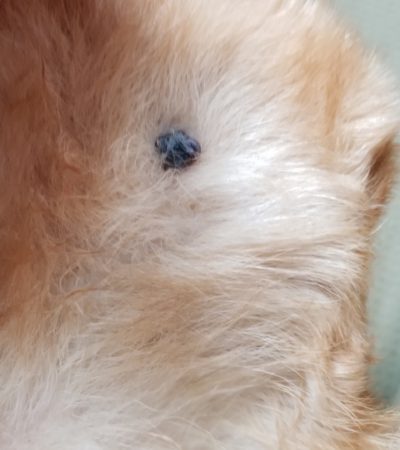“Can you come look? I think my dog has a tick on him!”
“My dog has a tick – please come take it off NOW!”
“How do you tell if it’s a tick or a mole on my dog? And how do I remove it?”
These are very common questions I am asked throughout spring and summer. With this summer being particularly “tick-filled,” at least in the Midwest, the concerns of pet owners are increased this year.
Good news – in my experience 99% of suspected ticks are not ticks at all! They are age spots (AKA moles), nipples (yes, boy dogs have those too), skin tags, or other benign masses. Ironically, when I do find a tick on a dog, the owner never noticed it or suspected it!
So how can you tell if it’s a tick? There are three key features ticks have that other normal anatomy on dogs will not:
1- Ticks have legs. Eight of them. They are not insects, but arachnids. Yep, that’s the spider family. You can see the eight legs. If the tick is dead, the legs will be curled up next to the body, but you can still see them. No legs? Not a tick!
2 – Live ticks move. Even if they are attached, touch it and see if the legs wiggle. If it’s dead, they won’t, as the legs will be contracted. If it is not attached, get ready for a chase! Ticks can run surprisingly fast! (think spider!)
3 – Ticks are floppy. They attach with tiny mouths located in tiny heads. Even if it’s engorged, the base of attachment is still the little head. Most lumps and nipples on dogs have a wide base of attachment and can’t be flopped (most, not all- some skin tags and nipples are very floppy!). If it’s really stuck to your dog and not moving, it’s not a tick. If you can wiggle it, it could be a tick or a floppy mass. Check for legs (see #1).
So you’ve confirmed it is a tick on your dog or cat. Now what? Light a match? Get essential oils? Say a chant? It is actually very simple to pull a tick off a dog or cat. You pull. Seriously, that’s it. No twisting, no matches, nothing fancy. Get a tweezers if you can’t get a good hold of it. Or, I’ve removed many ticks from pets with my bare fingers in a pinch (when you’re on a hike, you do what you gotta do!). Grasp firmly at the base, (ideally with a tweezers) as close to the skin as possible, and pull with confidence! You may get a little piece of skin the tick was attached to – that means you got it all! If you’re worried you left the head in, do not go digging into your pet’s skin. You can do much more damage with your search than a tiny piece of tick can do. The area where the tick was feeding may be inflamed or itchy for a few days, but rarely requires medical treatment.
The important thing to NOT do when removing a tick is squeeze the body. That can actually squish the disease-causing bacteria into your pet – not where we want it! This is why you pinch at the base/head, which does not squeeze the body.
Good news – ticks have to attach to a pet and feed for hours in order to transmit diseases like Lyme, Ehrlichiosis, Rocky Mountain Spotted Fever, or Anaplasmosis. So if you find a tick that is not engorged, chances are it has not been attached for long. Remove it and move on. There are no tests we can do on your pet that day that will tell us if he contracted a disease – those take weeks to show up. If your pet is sick – you’ll see symptoms of fever, lethargy, and a generally sick pet.
So you’ve boldly removed the tick from your pet. Congratulations! Now what?
These suckers are hard to kill! Rinsing them down a drain may not suffice – I’ve seen them crawling out of the drain! Flushing down a toilet is effective, as is dumping the the tick into a container of alcohol or insecticide.
Hopefully you have your pet on a product meant to kill or repel ticks, if your lifestyle and environment put your pet at risk. Ticks typically live in tall grass and brushy areas. That said, today I pulled a tick off of a 16 year old lap dog in a condo – so you never know! Your vet can guide you on which tick prevention and killing products they carry and prescribe. Some common ones are Frontline (now available over-the-counter!), Seresto collars, Bravecto, Nexgard, Simparica, Advantix, and Vectra. Note that products like Comfortis, Trifexis, Sentinel, and Advantage work on fleas but have NO tick activity!
Pictures of lumps, skin tags, nipples, and moles that are all NOT ticks:

ga(‘create’, ‘UA-69077714-1’, ‘auto’); ga(‘send’, ‘pageview’);

Save


